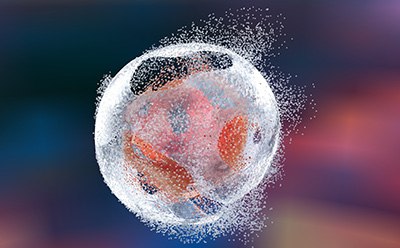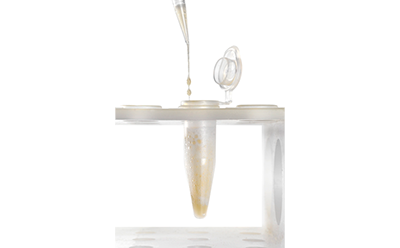全细胞裂解试剂和增强剂
蛋白质的分离和纯化需要通过破坏细胞或组织样本进行细胞裂解,并提取相关蛋白质部分。 这一步骤至关重要,因为处理方法可能会影响目标蛋白质的完整性和活性,或使其暴露于降解条件下。 探索细胞裂解缓冲液、蛋白质提取试剂盒和试剂以及增强剂(如提取酶),以满足您的特定细胞类型和应用需求。
Products
用于细胞裂解的 RIPA 缓冲液
放射免疫沉淀测定(RIPA)缓冲液用于快速裂解粘附和悬浮培养的哺乳动物细胞并溶解其中的蛋白质。放射免疫共沉淀测定(RIPA)缓冲液用于快速裂解细胞和溶解粘附和悬浮培养的哺乳动物细胞中的蛋白质。RIPA 细胞裂解缓冲液能有效地裂解细胞和溶解蛋白质,同时避免蛋白质降解和干扰免疫活性及生物活性。RIPA 缓冲液还能最大限度地减少非特异性蛋白质结合相互作用,确保在免疫沉淀和分子牵引检测中实现低背景。
BugBuster®蛋白质提取试剂
BugBuster®蛋白质提取试剂经过优化,可在非变性条件下从大肠杆菌中提取蛋白质。大肠杆菌的蛋白质提取进行了优化。
BugBuster®主混合物将 BugBuster®细菌蛋白提取试剂与 Benzonase® 核酸酶和 rLysozyme™ 溶液相结合,实现了方便的一体化蛋白提取和核酸消化。
- YeastBuster™蛋白提取试剂可用于酵母培养物的蛋白提取。
- CytoBuster™蛋白质提取试剂可用于昆虫和哺乳动物细胞的裂解和蛋白质提取。
- NucBuster™试剂可在 30 分钟内通过简单的两步方案提取核蛋白。
- PhosphoSafe™提取试剂包括磷酸酶抑制剂,可保持样品蛋白质的磷酸化状态。
CelLytic
CelLytic™裂解试剂是根据细胞或组织类型和目标蛋白定位情况专门配制的,可在非变性条件下裂解和提取细胞蛋白。
PopCulture®。试剂
PopCulture®试剂可直接从培养基中的细胞提取蛋白质,无需离心。昆虫 PopCulture® 试剂可直接在无血清培养基中裂解昆虫细胞,是许多小样本表达筛选的理想选择。
增强剂:提取酶和其他试剂
- rLysozyme™ 溶液:酶法裂解细菌肽聚糖层中的键,突破细胞壁进行裂解或球形体预处理,对革兰氏阳性菌特别有效。
- 色肽酶:溶菌性丝氨酸蛋白酶,用于裂解对溶菌酶有抗性的革兰氏阳性细菌。
- Lyticase:酶法裂解酵母细胞壁的β-葡聚糖层,从而获得细胞内容物。消化外层有助于为球形细胞裂解或转化做好准备。
- 几丁质酶:真菌和其他生物体内的几丁质降解可安全地消化细胞壁。
- 多种水解混合物:MetaPolyzyme,6 种酶的混合物,用于难水解样品。
- DNA-free lytic enzymes:用于对微生物 DNA 污染敏感的低生物量样品。
- Benzonase® 核酸酶:可降解所有类型的核酸,提高蛋白质提取效率,降低粘度和检测干扰,实现准确的样品处理和更快的层析。了解更多信息,请访问 ExoPolyzyme: 用于酶解细胞外生物膜基质,是 7 种酶的混合物,可分解 ECM 中的不同成分,如 EPS 和脂质。
相关产品
相关资源
- Brochure: Refine Protein Preparation - Tools for Better Protein Analysis
With over 50 years of experience in developing protein sample preparation technologies, we are constantly innovating new tools to offer you rapid and efficient solutions that can be smoothly integrated into your workflow.
- Article: Benzonase® Nuclease Q&A
This page lists nine frequently asked questions and answers about Benzonase® Nuclease.
- Article: Lysing Enzymes
裂解酶提供了一种非机械式细胞裂解和原生质体准备方法。这看上去是个非常简单的过程:只需加入酶,将试管放入水浴然即可。但这过程中到底发生了什么?
- Article: BugBuster® and Benzonase® Reagents are the Clear Solutions to Simple, Efficient Extraction of E. coli Proteins
This article shows the use of BugBuster® and Benzonase® as protein purification tools to extract recombinant proteins from E. coli and to reduce the viscosity of the extract.
- Article: Use of BugBuster® and Lysonase™ Reagents for Efficient Protein Extraction from Gram-positive Bacteria
The combination of BugBuster® and Lysonase™ reagents greatly enhances the release of soluble proteins from Gram-positive bacteria.
- Article: BugBuster® Plus Lysonase™ Kit: Cell Lysis and Nucleic Acid Removal for Gram-negative and Gram-positive Bacteria
Cell lysis and nucleic acid removal for Gram-negative and Gram-positive bacteria using the BugBuster Plus Lysonase™ Kit.
如要继续阅读,请登录或创建帐户。
暂无帐户?
